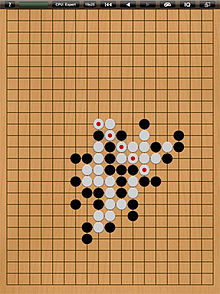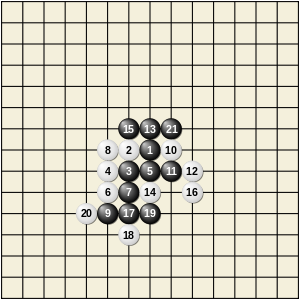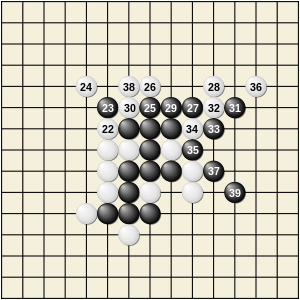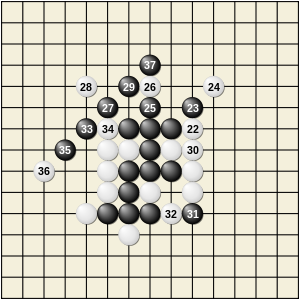- Gomoku
-
Gomoku is an abstract strategy board game. Also called Gobang or Five in a Row, it is traditionally played with go pieces (black and white stones) on a go board (19x19 intersections); however, because once placed, pieces are not moved or removed from the board, gomoku may also be played as a paper and pencil game. This game is known in several countries under different names.
Black plays first, and players alternate in placing a stone of their color on an empty intersection. The winner is the first player to get an unbroken row of five stones horizontally, vertically, or diagonally.
Contents
Origin
The name "Gomoku" is from the Japanese language, in which it is referred to as gomokunarabe (五目並べ). Go means five, moku is a counter word for pieces and narabe means line-up. The game is also popular in Korea, where it is called omok (오목(五目)) which has the same structure and origin as the Japanese name.
In the nineteenth century, the game was introduced to Britain where it was known as Go Bang, said to be a corruption of Japanese goban, said to be adapted from Chinese chee bahn (qí bàn) 'chess-board'.[1]
Example game
This game on the 15×15 board is adapted from the paper "Go-Moku and Threat-Space Search".[2]
The opening moves show clearly black's advantage. An open row of three (one that is not blocked by an opponent's stone at either end) has to be blocked immediately, or countered with a threat elsewhere on the board. If not blocked or countered, the open row of three will be extended to an open row of four, which threatens to win in two ways. White has to block open rows of three at moves 10, 14, 16 and 20, but black only has to do so at move 9.
Move 20 is a blunder for white (it should have been played next to black 19). Black can now force a win against any defence by white, starting with move 21.
There are two forcing sequences for black, depending on whether white 22 is played next to black 15 or black 21. The diagram on the right shows the first sequence. All the moves for white are forced. Such long forcing sequences are typical in gomoku, and expert players can read out forcing sequences of 20 to 40 moves rapidly and accurately.
The diagram on the right shows the second forcing sequence. This diagram shows why white 20 was a blunder; if it had been next to black 19 (at the position of move 32 in this diagram) then black 31 would not be a threat and so the forcing sequence would fail.
Variations and opening rules
Free-style gomoku is the basic game as described above.
Standard Gomoku
- Standard gomoku requires a row of exactly five stones for a win: rows of six or more, called overlines, do not count.
- The rule of three and three bans a move that simultaneously forms two open rows of three stones (rows not blocked by an opponent's stone at either end).
- The rule of four and four bans a move that simultaneously forms two rows of four stones (open or not).
Caro
- In Caro, popular among Vietnamese, the winner must have an unbroken row of five stones and this row must not be blocked at either end. This rule makes Gomoku more flexible and provides more power for White to defend.
Omok
- Omok is played the same as Standard Gomoku; however, it is played on a 15×15 board and does not include the rule of four and four. The overlines and three and three rules still apply.
Other Similar Games
- Renju is played on a 15×15 board, with the rules of three and three, four and four, and overlines applied to black only. There are special rules for the opening.
- Ninuki-renju or Wu is a variant which adds capturing to the game; it was published in the USA in a slightly simplified form under the name Pente.
- m,n,k-games are a generalization of gomoku to a board with m×n intersections, and k in a row needed to win.
- Connect(m,n,k,p,q) games are another generalization of gomoku to a board with m×n intersections, k in a row needed to win, p stones for each player to place, and q stones for the first player to place for the first move only.
Analysis
Computer search by L. Victor Allis has shown that on a 15×15 board, black wins with perfect play.[3] This applies regardless of whether overlines are considered as wins, but it assumes that the rule of three and three is not used. It seems very likely that black wins on larger boards too.[citation needed] In any size of a board, freestyle gomoku is an m,n,k-game, and it is known that the second player does not win. With perfect play, either the first player wins or the result is a draw.
Generalized gomoku is PSPACE-complete.[4]
See also
- Game theory
- Board game
- Irensei
- Solved board games
- Connect6, a revised version of Gomoku
- Pente
- Connect Four
- Reversi
References
- ^ OED citations: 1886 GUILLEMARD Cruise ‘Marchesa’ I. 267 Some of the games are purely Japanese..as go-ban. Note, This game is the one lately introduced into England under the misspelt name of Go Bang. 1888 Pall Mall Gazette 1. Nov. 3/1 These young persons..played go-bang and cat's cradle.
- ^ L. Victor Allis, H. J. van den Herik, M. P. H. Huntjens. "Go-Moku and Threat-Space Search" (PDF). http://home.mit.bme.hu/~gtakacs/download/allis1994.pdf.
- ^ L. Victor Allis (1994) (PDF). Searching for Solutions in Games and Artificial Intelligence. Ph.D. thesis, University of Limburg, The Netherlands. ISBN 9090074880. http://www.unimaas.nl/games/files/phd/SearchingForSolutions.pdf.
- ^ Stefan Reisch (1980). "Gobang ist PSPACE-vollständig (Gomoku is PSPACE-complete)". Acta Informatica 13: 59–66.
- Further reading
- Five-in-a-Row (Renju) For Beginners to Advanced Players ISBN 4-87187-301-3
External links
Categories:- Abstract strategy games
- Traditional board games
- Japanese games
- Paper-and-pencil games
- PSPACE-complete problems
Wikimedia Foundation. 2010.




